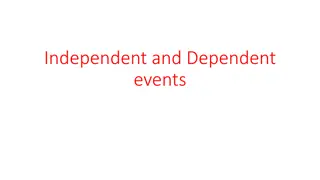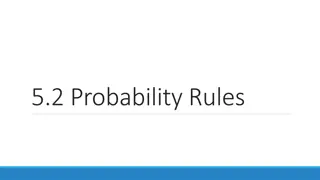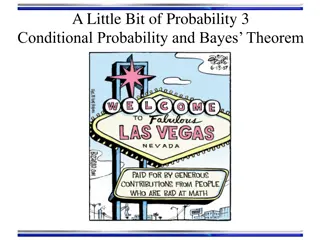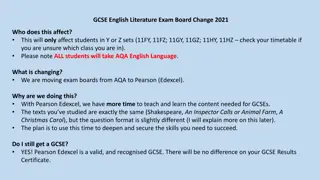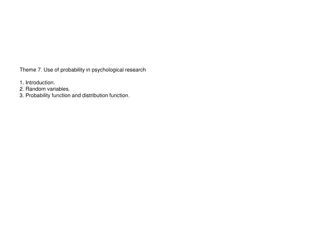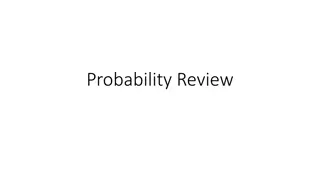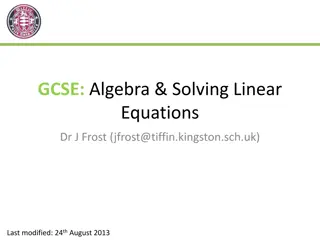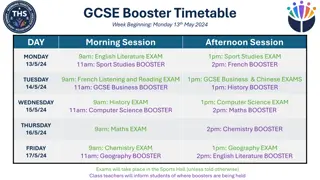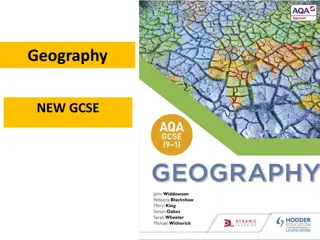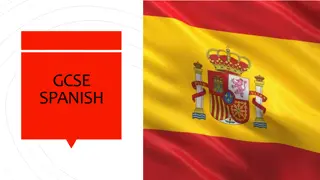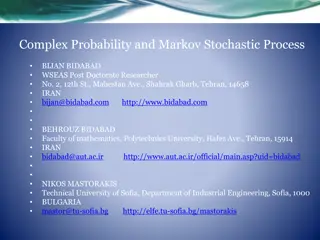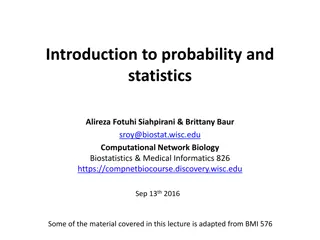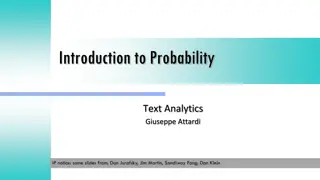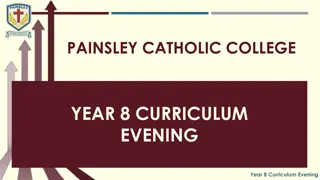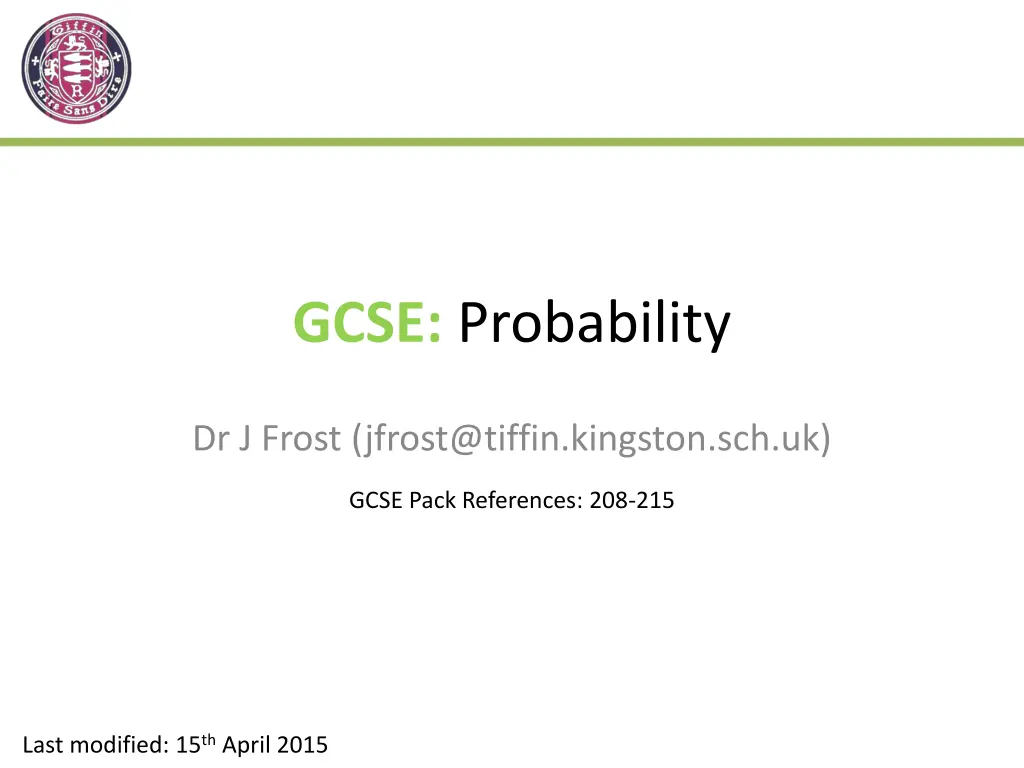
GCSE Probability: Understanding Probabilities and Combinatorics
Explore GCSE level probability concepts including writing probabilities using fractions, percentages, or decimals, comparing experimental data with theoretical probabilities, understanding combinatorics, and solving probability puzzles. Enhance your knowledge on calculating probabilities of successive events, conditional probabilities, and more!
Download Presentation

Please find below an Image/Link to download the presentation.
The content on the website is provided AS IS for your information and personal use only. It may not be sold, licensed, or shared on other websites without obtaining consent from the author. If you encounter any issues during the download, it is possible that the publisher has removed the file from their server.
You are allowed to download the files provided on this website for personal or commercial use, subject to the condition that they are used lawfully. All files are the property of their respective owners.
The content on the website is provided AS IS for your information and personal use only. It may not be sold, licensed, or shared on other websites without obtaining consent from the author.
E N D
Presentation Transcript
GCSE: Probability Dr J Frost (jfrost@tiffin.kingston.sch.uk) GCSE Pack References: 208-215 Last modified: 15th April 2015
GCSE Specification 208. Write probabilities using fractions, percentages or decimals 209. Compare experimental data and theoretical probabilities. Compare relative frequencies from samples of different sizes. 210. Find the probability of successive events, such as several throws of a single die. Identify different mutually exclusive outcomes and know that the sum of the probabilities of all these outcomes is 1. 211. Estimate the number of times an event will occur, given the probability and the number of trials. 212. List all outcomes for single events, and for two successive events, systematically. Use and draw sample space diagrams 213. Understand conditional probabilities. Use a tree diagram to calculate conditional probability. 214. Solve more complex problems involving combinations of outcomes. 215. Understand selection with or without replacement. Draw a probability tree diagram based on given information.
RECAP: How to write probabilities Probability of winning the UK lottery: 1 in 14,000,000 ___1___ 14000000 ? ? Odds Form Fractional Form 0.000000714 0.0000714% ? ? Decimal Form Percentage Form Which is best in this case?
RECAP: Combinatorics Combinatorics is the number of ways of arranging something . We could consider how many things could do in each slot , then multiply these numbers together. 1 How many 5 letter English words could there theoretically be? e.g. B I L B O ? 26 x 26 x 26 x 26 x 26 = 265 2 How many 5 letter English words with distinct letters could there be? S M A U G ? 26 x 25 x 24 x 23 x 22 = 7893600 3 How many ways of arranging the letters in SHELF? E L F H S 5 x 4 x 3 x 2 x 1 = 5! ( 5 factorial ) ?
STARTER: Probability Puzzles Recall that: ???? ??? ???????? ????? ???????? ???????? ? ????? = In pairs/groups or otherwise, work out the probability of the following: Seeing exactly two heads in four throws of a coin. ? ??=? I randomly pick a number from 1 to 4, four times, and the values form a run of 1 to 4 in any order (e.g. 1234, 4231, ...). ?! ??= If I toss a coin twice, I see a Heads and a Tails (in either order). ? ?=? If I toss a coin three times, I see a 2 Heads and 1 Tail. ? ? In 3 throws of a coin, a Heads never follows a Tails. ? ?=? ? 1 5 ? ? ? ? 2 ?? ???= ? ? ? ?? 3 After shuffling a pack of cards, the cards in each suit are all together. ??!? ?! ??! I have a bag of ? different colours of marbles and ? of each. What s the probability that upon picking ? of them, they re all of different colours? ???! ?? ? ! ??! ? = ? ?? ? ??????? ??????? ??????? ? Throwing three square numbers on a die in a row. ? ???= 4 OMG ? ? ?? ?
How can we find the probability of an event? 1. We might just know! 2. We can do an experiment and count outcomes We could throw the dice 100 times for example, and count how many times we see each outcome. For a fair die, we know that the probability of each outcome is 1 definition of it being a fair die. 6, by Outcome 1 2 3 4 5 6 Count 27 13 10 30 15 5 27 100 13 100 10 100 30 100 15 100 5 ? R.F. 100 This is known as a: This is known as an: Theoretical Probability Experimental Probability When we know the underlying probability of an event. Also known as the relative frequency , it is a probability based on observing counts. ? ? ? ????? =????? ?? ??????? ?????? ?? ??????
Check your understanding Question 1: If we flipped a (not necessarily fair) coin 10 times and saw 6 Heads, then 6 10 is the true probability of getting a Head? No. It might for example be a fair coin: If we throw a fair coin 10 times we wouldn t necessarily see 5 heads. In fact we could have seen 6 heads! So the relative frequency/experimental probability only provides a sensible guess for the true probability of Heads, based on what we ve observed. ? Question 2: What can we do to make the experimental probability be as close as possible to the true (theoretical) probability of Heads? Flip the coin lots of times. I we threw a coin just twice for example and saw 0 Heads, it s hard to know how unfair our coin is. But if we threw it say 1000 times and saw 200 heads, then we d have a much more accurate probability. The law of large events states that as the number of trials becomes large, the experimental probability becomes closer to the true probability. ?
RECAP: Estimating counts and probabilities A spinner has the letters A, B and C on it. I spin the spinner 50 times, and see A 12 times. What is the experimental probability for P(A)? Answer: ?? ??= ?.?? ? The probability of getting a 6 on an unfair die is 0.3. I throw the die 200 times. How many sixes might you expect to get? Answer: ??? ?.? = ?? times?
Test Your Understanding The table below shows the probabilities for spinning an A, B and C on a spinner. If I spin the spinner 150 times, estimate the number of Cs I will see. A Outcome A B C Probability 0.12 0.34 P(C) = 1 0.12 0.34 = 0.54 Estimate Cs seen = 0.54 x 150 = 81 ? B I spin another spinner 120 times and see the following counts: Outcome A B C Count 30 45 45 What is the relative frequency of B? 45/120 = 0.375?
So far 208. Write probabilities using fractions, percentages or decimals 209. Compare experimental data and theoretical probabilities. Compare relative frequencies from samples of different sizes. 210. Find the probability of successive events, such as several throws of a single die. Identify different mutually exclusive outcomes and know that the sum of the probabilities of all these outcomes is 1. 211. Estimate the number of times an event will occur, given the probability and the number of trials. 212. List all outcomes for single events, and for two successive events, systematically. Use and draw sample space diagrams 213. Understand conditional probabilities. Use a tree diagram to calculate conditional probability. 214. Solve more complex problems involving combinations of outcomes. 215. Understand selection with or without replacement. Draw a probability tree diagram based on given information.
RECAP: Events Examples of events: Throwing a 6, throwing an odd number, tossing a heads, a randomly chosen person having a height above 1.5m. ? The sample space is the set of all outcomes. An event is a description of one or more outcomes. It is a subset of the sample space. ? The sample space ? ? ? ? ? =1 2 3 5 3 We often use capital letters to represent an event, then use ?(?) to mean the probability of it. 1 From Year 7 you should be familiar with representing sets using a Venn Diagram, although you won t need to at GCSE.
Independent Events When a fair coin is thrown, what s the probability of: ? ? =? ? ? And when 3 fair coins are thrown: 1 8 ? p(1st coin H and 2nd coin H and 3rd coin H) = Therefore in this particular case we found the following relationship between these probabilities: P(event1and event2and event3) = P(event1) x P(event2) x P(event3) ?
Mutually Exclusive Events If A and B are mutually exclusive events, they can t happen at the same time. Then: P(A or B) = P(A) + P(B) Independent Events If A and B are independent events, then the outcome of one doesn t affect the other. Then: P(A and B) = P(A) P(B)
But be careful 1 2 3 4 5 6 7 8 1 2 P(num divisible by 2) = ? 1 4 P(num divisible by 4) = ? 1 4 P(num divisible by 2 and by 4) = ? Why would it have been wrong to multiply the probabilities?
Add or multiply probabilities? + Getting a 6 on a die and a T on a coin. + Hitting a bullseye or a triple 20. Getting a HHT or a THT after three throws of an unfair coin (presuming we ve already worked out P(HHT) and P(THT). + Getting 3 on the first throw of a die and a 4 on the second. + Bart s favourite colour being red and Pablo s being blue. + + Shaan s favourite colour being red or blue.
Independent? Event 1 Event 2 Throwing a heads on the first flip. Throwing a heads on the second flip. Yes No It rains tomorrow. It rains the day after. No Yes That I will choose maths at A Level. That I will choose Physics at A Level. No Yes Have a garden gnome. Being called Bart. Yes No
Test Your Understanding The probability that Kyle picks his nose today is 0.9. The probability that he independently eats cabbage in the canteen today is 0.3. What s the probability that Kyle picks his nose, but doesn t eat cabbage? ?.? ?.? = ?.?? ? a I pick two cards from the following. What is the probability the first number is a 1 and the second number a 2? b 1 2 2 3 ? ? ? ? ? ?= ?? I throw 100 dice and 50 coins. What s the probability I get all sixes and all heads? ? ? c ??? ?? ? ? ?
Tree Diagrams Question: Given there s 5 red balls and 2 blue balls. What s the probability that after two picks we have a red ball and a blue ball? After first pick, there s less balls to choose from, so probabilities change. Bro Tip: Note that probabilities generally go on the lines, and events at the end. 4 6 R ? 5 7 ? R B 2 6 ? 5 6 R ? 2 7 B ? B 1 6 ?
Tree Diagrams Question: Give there s 5 red balls and 2 blue balls. What s the probability that after two picks we have a red ball and a blue ball? We multiply across the matching branches, then add these values. 4 6 R 5 7 R 5 21 B ? 2 6 5 21 5 6 R ? 2 7 B B 1 6 P(red and blue) = 10 21?
Summary ...with replacement: The item is returned before another is chosen. The probability of each event on each trial is fixed. ...without replacement: The item is not returned. Total balls decreases by 1 each time. Number of items of this type decreases by 1. Note that if the question doesn t specify which, e.g. You pick two balls from a bag , then PRESUME WITHOUT REPLACEMENT.
Example (on your sheet) 3 8 ? 3 8 ? 5 8 ? 5 8 5 8=25 ? 3 8 ? 64 5 8 ? 3 8 5 =15 32 5 8 3 + ? 8 8
Question 1 1 5 1 1 5 4 25=17 1 ? 5= 25 4 5 1 ? ? 8 + = 5 5 25 8 1 25
Question 2 0.9 0.9 ? 0.1 ? 0.9 0.1 ? 0.1 0.92= 0.81 ? 2 0.1 0.9 = 0.18 ?
Question 3 4 13 9 13 5 13 8 13 5 ? 14 ? 9 ? 14 9 13=36 9 13 8 ? 14 5 14 two consonants? 91 9 5 =45 91 14 ? + 13
Question 4 2 9 7 9 ? 3 ? 10 3 9 6 9 7 ? 10 10 7 3 10 3 ? 7 7 + = 9 9 30 30=23 ? 7 1 30
Question 5 The Birthday Paradox ??? ??? ? ??? ??? ? ??? ??? ??? ??? ??? ??? ??? ? ???= ?.???? ? ?.???? = ?.???? That s surprisingly likely! ?
Question 6 ? 64 110 ?
Question 7 (Algebraic Trees) ? 4 ? 4 ? 4 ? ?2 16= ?2= 1 ? = 1 1 4= ? 16 1 16
Question 8 ? 1 9 ? 10 10 ? 1 ? ? 1 = 56 ?2 ? = 56 ?2 ? 56 = 0 ? + 7 ? 8 = 0 ? = 8 ? =? ? 1 =28 45 9 90 ? 10 1 2 2 1 ? ?? = 9= 90= 45
Question [Maclaurin M68] I have 44 socks in my drawer, each either red or black. In the dark I randomly pick two socks, and the probability that they do not match is 192 of the 44 socks are red? 473. How many Suppose there are ? red socks. There are therefore 44 ? grey socks. ? 44 44 ? ? 44 ? = 384 44? ?2= 384 ?2 44? + 384 = 0 ? 32 ? 12 = 0 ? = 32 ?? ? = 12 =? 44 ? 946 =192 473 ? ?? ?? ?? = 2 43 ?
Doing without a tree: Listing outcomes It s usually quicker to just list the outcomes rather than draw a tree. 14 31 17 30 16 1904 13485 BGG: 29= 17 31 14 30 16 ? Working 1904 13485 GBG: 29= 17 31 16 30 14 1904 13485 GGB: 29= 1904 4495 Answer = ?
Test Your Understanding I have a bag consisting of 6 red balls, 4 blue and 3 green. I take three balls out of the bag at random. Find the probability that the balls are the same colour. Q RRR: ? GGG: ? BBB: ? ? ?? ? ?? ? ?? ? ??= ? ??= ? ??= ??? ???? ? ???? ?? ???? ??? ????= ?? ?? ?? ? ?? ??? ? ???? ?????? = What s the probability they re of different colours: RGB: ? Each of the ?! = ? orderings of RGB will have the same probability. So ??? ? = ??? ? ?? ? ??= ? ?? ??? ? ? ??
Probability Past Paper Questions Provided on sheet. Remember: 1. List the possible events that match. 2. Find the probability of each (by multiplying). 3. Add them together.
Past Paper Questions 2 ? 42 16 42 ?
Past Paper Questions 222 380 ?
Past Paper Questions ? 64 110 ?


